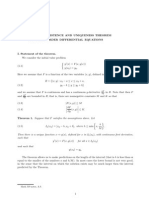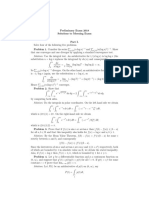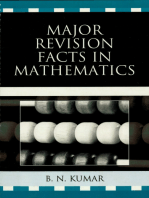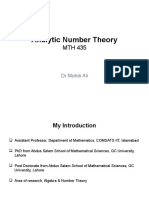Math 8201 Homework 10 Fall 2014: Tianyu Tao November 25, 2014
Math 8201 Homework 10 Fall 2014: Tianyu Tao November 25, 2014
Uploaded by
Tianyu TaoCopyright:
Available Formats
Math 8201 Homework 10 Fall 2014: Tianyu Tao November 25, 2014
Math 8201 Homework 10 Fall 2014: Tianyu Tao November 25, 2014
Uploaded by
Tianyu TaoOriginal Description:
Original Title
Copyright
Available Formats
Share this document
Did you find this document useful?
Is this content inappropriate?
Copyright:
Available Formats
Math 8201 Homework 10 Fall 2014: Tianyu Tao November 25, 2014
Math 8201 Homework 10 Fall 2014: Tianyu Tao November 25, 2014
Uploaded by
Tianyu TaoCopyright:
Available Formats
Math 8201 Homework 10 Fall 2014
Tianyu Tao
November 25, 2014
Problem 1:
p. 133 Exx 1.
Proof: Let : F [x] F [u] be the homomorphism which is the extension of
the homomorphism from F to F [u] (which equals identity on F ) and sends x
to u. From the problem we know that u is just the equivalence class of x in
F [x]/(f (x)), so is just the projection map x 7 x + (f (x)) = x, and F [u] '
F [x]/(f (x)). In particular (f (x)) = ker so f (u) = 0 in F [u]. In other words,
un = (a1 xn1 + an ) where ai F , thus one can reduce higher powers of u in
F [u] using the above relation, recall a general element in F [u] is a polynomial of
u with arbitrary degree, it follows then every element in F [u] has the form
b0 + b1 u + bn1 un1 , bj F
To see this form is unique, if there are b0j , bj F such that
b0 + b1 u + bn1 un1 = b00 + b01 u + b0n1 un1
then we have (b0 b00 ) + (bn1 b0n1 )un1 = 0, but f (x) is the minimal polynomial over F of u, and degree of f (x) is n which is bigger than n 1, so it must
be that bj b0j = 0 for each j.
Problem 2:
p.133 Exx 2.
Proof. By theorem 2.16 we just need to show f (x) = x3 + 3x 2 is irreducible
in Q[x]. Since f (x) is a polynomial of degree 3, irreduciblility will follow once we
show that f (x) has no rational roots, this is confirmed by the rational roots test:
the only possible rational root of f are 21 , neither of which works.
Math 8201 Homework 10
Tianyu Tao
Now (2u2 + u 3)(3u2 4u + 1) = 6u4 5u3 11u2 + 13u 3, use the relation
u + 3u 2 = 0 in F [u], we have it simplifies to 29u2 + 40u 13, and we have
(u2 u + 4)1 = 61 u + 16 since
3
1
1
6 = ((u3 + 3u + 4) (u3 + 3u 2))
6
6
1 3
u 1
= (u + 3u + 4) = ( + )(u2 u + 4).
6
6 6
1=
Problem 3:
p.133 Exx 4.
Proof: Again, this is a polynomial of degree 3, all we need to check is that neither
0 nor 1 in Z/(2) is a root of f (x) = x3 + x2 + 1, this is straight forward:
03 + 02 + 1 = 1; 13 + 12 + 1 = 1 in Z/(2).
It then follows that Z/(2)[x]/(f (x)) is a field. There are eight elements
0, 1, u, u + 1, u2 , u2 + 1, u2 + u, u2 + u + 1
where u = x + (f (x)), since the relation u3 + u2 + 1 = 0 reduces element in
Z/(2)[x]/(f (x)) to quadratic polynomials with coefficient in Z/(2), which provides
23 choices for 3 spots for coefficients and 2 values for coefficients.
Problem 4:
p.133 Exx 8.
Proof: Recall on page 100, we have
i2 = j 2 = k 2 = 1
ij = ji = k, jk = kj = i, ki = ik = j,
in H. In particular, let a, b R with a2 + b2 = 1, then
(ai + bj)2 = a2 i2 + abij + abji + b2 j 2 = (a2 + b2 ) = 1
hence there are infinitely many u H with u2 = 1.
Math 8201 Homework 10
Problem 5:
Tianyu Tao
p.134 Exx 17.
Proof: The main point here is that if f (x) = axn and g(x) = b where a, b R,
then the product of the two polynomials f and g is
f g(x) = abxn
as in the definition of product of polynomials on page 120: we always write the
coefficient on the left. Then the proof of the formula goes through as stated in the
problem.
Problem 6:
p.140 Exx 1.
Proof: We follow the process describedPin the proof of theorem 2.20 on page 139:
the highest monomial degree in f = i,j,k6= x2i x2j xk is (2, 2, 1, 0, , 0), which is
the same in the product p2 p3 . We then consider the highest monomial degree in
f1 = f p2 p3 , and proceed...
The algorithm is infeasible... I got f = p2 p3 5p1 p4 10p5 in the end.
Problem 7:
p.140 Exx 2.
Q
Proof: Since = i<j (xi xj )2 , let Sn , then
Y
(x(i) x(j) ) = (1)m
i<j
for some m because is a bijection between
Q indices, if i < j, then either xi xj
or xj xi will be contained in the product i<j (x(i) x(j) ), then clearly square
makes it symmetric.
For r = 3, use the algorithm as in the proof of theorem 2.20, which is tediously
long: the highest monomial degree in 2 is (4, 2, 0), this gives the term (p1 p2 )2 ,
then in 2 (p1 p2 )2 , the highest monomial degree is (4, 1, 1), which gives the term
4p31 p3 , and in 2 (p1 p2 )2 + 4p31 p3 the highest degree is (3, 3, 0), gives 4p32 . Next
highest degree is (3, 2, 1), gives 18p1 p2 p3 , and by luck we find next step is the final
step: the highest degree is (0, 0, 2) gives 27p23
In summary one got
2 = (p1 p2 )2 4p31 p3 4p32 4p31 p3 + 18p1 p2 p3 27p33 .
Math 8201 Homework 10
Problem 8:
Tianyu Tao
Written. [????]
Proof. The formula in problem 17 page 134 says in any ring R, commutative or
not we have
f (t) = q(t)(t a) + f (a)
for f R[t], a R, and the polynomial q(t) is unique. Now consider the polynomial ring over the non-commutative ring Mn (R), where the any scalar a is identified
with the matrix aIn , note we have the factorization
f (t) = det(t A) = adj(t A)(t A)
where adj is the adjoint matrix. Comparison with the formula above gives the
remainder f (A) = 0In .
NowP
adj(t A) is the q(t) in problem 17 page 133, there it was showed that
n
j1
q(t) =
where qj = aj + aj+1 A + + an Anj , and aj are the
j=1 qj (tIn )
coefficients of f (t) = det(t A).
Math 8201 Homework 10
Problem 9:
Tianyu Tao
Written.
Proof. Perhaps the most convenient relation between the resultant and discriminant is the following:
n(n1)
R(f, f 0 ) = (1) 2
which is given as an exercise on Dummit and Foote (page 621), this can be shown
quite easily: In class we showed
R(f, g) =
n
am
n bm
m Y
n
Y
(ri sj )
i=1 j=1
if f (x) = a0 + + xn = (x r1 ) (x Qrn ) and g(x) = b0 + + xm =
(x s1 ) (x sm ). Then clearly R(f, g) = ni=1 g(ri ), take now g = f 0 , we have
!0
n
n Y
Y
X
0
g(x) = f (x) =
(x ri ) =
(x ri )
i=1
j=1 i6=j
So that
0
R(f, f ) =
n
Y
f 0 (ri ) =
= (1)
Y
(ri rj )
i6=j
n(n1)
2
Y
n(n1)
(ri rj )2 = (1) 2
i<j
And the resultant can be calculated from the associated Sylvester matrix, in
this case we have f (x) = xn + 0xn1 + + (a)x + (b), so we have a 2n 1 by
2n 1 Sylvester:
1 0, , 0 a b
0 0
0 1, , 0 0 a b 0
n 0, , 0 a 0 0 0
0, 0, , n
0
a
Compute its determinant... One should get
= (1)
n(n1)
2
[nn (b)n1 + (n 1)n1 (a)n ].
You might also like
- SolutionsDocument71 pagesSolutionsJoshua Mendez100% (2)
- IMO 2005 ShortlistDocument51 pagesIMO 2005 ShortlistAdnan GobeljićNo ratings yet
- International Competition in Mathematics For Universtiy Students in Plovdiv, Bulgaria 1995Document11 pagesInternational Competition in Mathematics For Universtiy Students in Plovdiv, Bulgaria 1995Phúc Hảo ĐỗNo ratings yet
- m820 Sol 2011Document234 pagesm820 Sol 2011Tom DavisNo ratings yet
- Solution:: Probability Assignment - I Name: Soumya Dasgupta (BMC202042)Document2 pagesSolution:: Probability Assignment - I Name: Soumya Dasgupta (BMC202042)Soumya Das guptaNo ratings yet
- Poly PDFDocument33 pagesPoly PDFManan GuptaNo ratings yet
- M110.3 Lec 1 - Polyomial RingsDocument5 pagesM110.3 Lec 1 - Polyomial RingsIsnihayaNo ratings yet
- HW6 AnsDocument12 pagesHW6 AnsHo Lan AuNo ratings yet
- 169 Functional EquationsDocument83 pages169 Functional Equationshungchng100% (5)
- Integration 1 PDFDocument44 pagesIntegration 1 PDFabhinavNo ratings yet
- Quadratic Mean Differentiability ExampleDocument5 pagesQuadratic Mean Differentiability ExamplemamurtazaNo ratings yet
- hw3 SolDocument8 pageshw3 SolanthalyaNo ratings yet
- Mathematics 315 - Assignment 2 Solns: e Cos x+2 XDocument4 pagesMathematics 315 - Assignment 2 Solns: e Cos x+2 XTom DavisNo ratings yet
- Bmo 2012 SolutionDocument4 pagesBmo 2012 SolutionjfmarquesNo ratings yet
- Math 319 Notes, A.SDocument13 pagesMath 319 Notes, A.SNahitMacitGuntepeNo ratings yet
- Economics 204 Fall 2012 Problem Set 5 Suggested SolutionsDocument8 pagesEconomics 204 Fall 2012 Problem Set 5 Suggested SolutionsFunWithNumbers88No ratings yet
- 11.1: Taylor Polynomials The Derivative As The First Taylor PolynomialDocument7 pages11.1: Taylor Polynomials The Derivative As The First Taylor PolynomialNguyên BùiNo ratings yet
- Allhw 3Document94 pagesAllhw 3kamilbismaNo ratings yet
- Solutions of Real Analysis 11Document8 pagesSolutions of Real Analysis 11Kartika NugraheniNo ratings yet
- HW 2 SolutionDocument7 pagesHW 2 SolutionAnonymous 9qJCv5mC0No ratings yet
- Cohomology Homework: Chapters 1 & 2: Daniel J. Cross April 11, 2007Document51 pagesCohomology Homework: Chapters 1 & 2: Daniel J. Cross April 11, 2007JackSmithNo ratings yet
- 12 International Mathematics Competition For University StudentsDocument4 pages12 International Mathematics Competition For University StudentsMuhammad Al KahfiNo ratings yet
- Math 8201 Homework 12 Fall 2014: Tianyu Tao December 9, 2014Document4 pagesMath 8201 Homework 12 Fall 2014: Tianyu Tao December 9, 2014Tianyu TaoNo ratings yet
- Midterm Solutions ENGR233Document5 pagesMidterm Solutions ENGR233SamNo ratings yet
- Metric MasDocument36 pagesMetric MasAngel Daniel Barria ComicheoNo ratings yet
- Dissertation OnDocument38 pagesDissertation OnSrabanta MandalNo ratings yet
- 12 International Mathematics Competition For University StudentsDocument4 pages12 International Mathematics Competition For University StudentsMuhammad Al KahfiNo ratings yet
- Paper V: A Cubic Convergent Iteration MethodDocument14 pagesPaper V: A Cubic Convergent Iteration MethodserigeNo ratings yet
- Predictor Corrector MethodDocument5 pagesPredictor Corrector Methodlazarbaruch3033No ratings yet
- 116 Problems in Algebra - Functional EquationsDocument23 pages116 Problems in Algebra - Functional EquationsHoàng LongNo ratings yet
- HW140B 2 SolutionsDocument6 pagesHW140B 2 SolutionsIdris AddouNo ratings yet
- Chapter 16.1 - 16.3 Solutions RogowskiDocument34 pagesChapter 16.1 - 16.3 Solutions RogowskiBossNo ratings yet
- Poisson's Equation by The FEM Using A MATLAB Mesh Generator: 4u F U 0 On DDocument6 pagesPoisson's Equation by The FEM Using A MATLAB Mesh Generator: 4u F U 0 On DRuben Dario Guerrero ENo ratings yet
- Math 3073: Notes: Trevor H. Jones January 5, 2010Document39 pagesMath 3073: Notes: Trevor H. Jones January 5, 2010SangEun HanNo ratings yet
- Chapter 5Document19 pagesChapter 5chilledkarthikNo ratings yet
- Puntos de EdpDocument3 pagesPuntos de EdpPetter LovedNo ratings yet
- hmw9 (MA504)Document5 pageshmw9 (MA504)EricBS100% (1)
- ( (0, 0) ) - But It's Easily Seen That F (X, Y) F ( X, Y) / ( (0, 0) ) - (This Is The Same As The Fact That Z 7 ZDocument4 pages( (0, 0) ) - But It's Easily Seen That F (X, Y) F ( X, Y) / ( (0, 0) ) - (This Is The Same As The Fact That Z 7 ZFrancesco GozziniNo ratings yet
- Problem Set 2Document8 pagesProblem Set 2سام النعمانNo ratings yet
- CProsolsDocument105 pagesCProsolsK Nirmala AnantapurNo ratings yet
- Solutions To Exercises 7.1: X Has Period TDocument16 pagesSolutions To Exercises 7.1: X Has Period TTri Phương NguyễnNo ratings yet
- Math 121 HW 7Document4 pagesMath 121 HW 7Claudia Vanessa VargasNo ratings yet
- SlidesCourse 14 OctDocument10 pagesSlidesCourse 14 OctRoosevelt BaşkanNo ratings yet
- Answers 5 2012Document11 pagesAnswers 5 2012Eric KerrNo ratings yet
- Solutions Manual To: An Introduction To Mathematical Finance: Options and Other TopicsDocument65 pagesSolutions Manual To: An Introduction To Mathematical Finance: Options and Other TopicsHanh VuNo ratings yet
- School of Mathematics and Physics, The University of QueenslandDocument1 pageSchool of Mathematics and Physics, The University of QueenslandVincent LiuNo ratings yet
- Problems by Jim Pitman. Solutions by George ChenDocument8 pagesProblems by Jim Pitman. Solutions by George ChenspitzersglareNo ratings yet
- Taylor Series NotesDocument5 pagesTaylor Series NotesMR I MacNo ratings yet
- Solutions of Homework Set #1 For Math 301Document2 pagesSolutions of Homework Set #1 For Math 301Jacky PoNo ratings yet
- Anasol 2018Document6 pagesAnasol 2018Atoloye Habeeb OlawaleNo ratings yet
- Lecture 31: Lagrange Multiplier Method: P DF DT T DR DT P P P PDocument2 pagesLecture 31: Lagrange Multiplier Method: P DF DT T DR DT P P P PSaurabh TomarNo ratings yet
- MIT Multivariable Calculus Exam A SolutionsDocument16 pagesMIT Multivariable Calculus Exam A Solutions15klaNo ratings yet
- Solutions To Tutorial 1 (Week 2) : Lecturers: Daniel Daners and James ParkinsonDocument11 pagesSolutions To Tutorial 1 (Week 2) : Lecturers: Daniel Daners and James ParkinsonTOM DAVISNo ratings yet
- Functional Operators, Volume 2: The Geometry of Orthogonal SpacesFrom EverandFunctional Operators, Volume 2: The Geometry of Orthogonal SpacesNo ratings yet
- Mathematics 1St First Order Linear Differential Equations 2Nd Second Order Linear Differential Equations Laplace Fourier Bessel MathematicsFrom EverandMathematics 1St First Order Linear Differential Equations 2Nd Second Order Linear Differential Equations Laplace Fourier Bessel MathematicsNo ratings yet
- Differentiation (Calculus) Mathematics Question BankFrom EverandDifferentiation (Calculus) Mathematics Question BankRating: 4 out of 5 stars4/5 (1)
- NLP ProblemsDocument26 pagesNLP ProblemsTianyu TaoNo ratings yet
- 4 Norm PDFDocument1 page4 Norm PDFTianyu TaoNo ratings yet
- Notes On Topology: 1 Fundamental Groups 2 Covering SpacesDocument3 pagesNotes On Topology: 1 Fundamental Groups 2 Covering SpacesTianyu TaoNo ratings yet
- Math 8202 Homework 5 Spring 2015: Tianyu Tao March 5, 2015Document4 pagesMath 8202 Homework 5 Spring 2015: Tianyu Tao March 5, 2015Tianyu TaoNo ratings yet
- Math 8201 Homework 12 Fall 2014: Tianyu Tao December 9, 2014Document4 pagesMath 8201 Homework 12 Fall 2014: Tianyu Tao December 9, 2014Tianyu TaoNo ratings yet
- Notes Gal ThyDocument16 pagesNotes Gal ThyTianyu TaoNo ratings yet
- Functional Analysis Lecture NotesDocument52 pagesFunctional Analysis Lecture NotesTianyu TaoNo ratings yet
- Math 8201 Homework 1 Fall 2014: Tianyu Tao September 9, 2014Document6 pagesMath 8201 Homework 1 Fall 2014: Tianyu Tao September 9, 2014Tianyu TaoNo ratings yet
- Math 541 Honors Paper: A Short Discussion On Solving For The Roots of Polynomials by RadicalsDocument8 pagesMath 541 Honors Paper: A Short Discussion On Solving For The Roots of Polynomials by RadicalsTianyu TaoNo ratings yet
- Math 8202 Homework 3 Spring 2015: Tianyu Tao February 11, 2015Document3 pagesMath 8202 Homework 3 Spring 2015: Tianyu Tao February 11, 2015Tianyu TaoNo ratings yet
- Homework 5Document4 pagesHomework 5Tianyu TaoNo ratings yet
- Exercise On DistributionsDocument1 pageExercise On DistributionsTianyu TaoNo ratings yet
- Gauss Problems: Math 521, Fall 2011 September 2, 2011Document1 pageGauss Problems: Math 521, Fall 2011 September 2, 2011Tianyu TaoNo ratings yet
- Descartes: Doubt and CertaintyDocument17 pagesDescartes: Doubt and CertaintyTianyu TaoNo ratings yet
- Algebra ReviewerDocument83 pagesAlgebra ReviewerKaye BatacanNo ratings yet
- 5 2 Factoring TrinomialsDocument10 pages5 2 Factoring Trinomialsapi-233527181No ratings yet
- Lecture Notes in Ordered Sets by DR Tero HarjuDocument77 pagesLecture Notes in Ordered Sets by DR Tero HarjuhumejiasNo ratings yet
- 1-50 MathDocument5 pages1-50 MathJaishenne CastuloNo ratings yet
- Gamma FunctionDocument18 pagesGamma FunctionNassim BOUKALNo ratings yet
- Xam Idea Mathematics Cbse Class 12 WWW - Examsakha.inDocument562 pagesXam Idea Mathematics Cbse Class 12 WWW - Examsakha.inAkash MansinghNo ratings yet
- Vectors: Physics For Scientists and Engineers, 10e Raymond A. Serway John W. Jewett, JRDocument41 pagesVectors: Physics For Scientists and Engineers, 10e Raymond A. Serway John W. Jewett, JRameliawenston3No ratings yet
- Session-9 (Error Detection)Document24 pagesSession-9 (Error Detection)Jyothsna YenumulaNo ratings yet
- +1 CBSE - MATHS CDF MATERIAL (01-36) .PMDDocument36 pages+1 CBSE - MATHS CDF MATERIAL (01-36) .PMDcernpaul100% (2)
- 1st Quarter MathematicsDocument7 pages1st Quarter Mathematicsangelen buhaweNo ratings yet
- Lagrange Interpolation ExplainedDocument2 pagesLagrange Interpolation ExplainedKundan KumarNo ratings yet
- Module - Ii Vector Differential Calculus - ContinuedDocument12 pagesModule - Ii Vector Differential Calculus - ContinuedharishNo ratings yet
- Guia de Estudio e Intervención PDFDocument202 pagesGuia de Estudio e Intervención PDFCarlos ColonNo ratings yet
- 22 Long Division of Polynomials PDFDocument4 pages22 Long Division of Polynomials PDFrona gabineteNo ratings yet
- Analytic Number Theory: DR Mohib AliDocument33 pagesAnalytic Number Theory: DR Mohib AliediealiNo ratings yet
- Lecture 4: Determinants: Elif TanDocument13 pagesLecture 4: Determinants: Elif Tansercan egilmezkolNo ratings yet
- 2014 H2 Maths Prelim Papers - JJC P1 Solution PDFDocument12 pages2014 H2 Maths Prelim Papers - JJC P1 Solution PDFcherylhzyNo ratings yet
- Sample Questions On Geometry and GroupsDocument4 pagesSample Questions On Geometry and GroupsjthryeboahNo ratings yet
- Qee 1Document26 pagesQee 1Annie JamesNo ratings yet
- DM UNIT-IV Definitions & TheoremsDocument26 pagesDM UNIT-IV Definitions & Theoremspec libraryNo ratings yet
- Algebra Fractions 1Document12 pagesAlgebra Fractions 1santhi100% (2)
- Class 8 CBSE Rational NumbersDocument11 pagesClass 8 CBSE Rational NumbersMohanaMisraNo ratings yet
- G10 Math Q2 Module-2Document12 pagesG10 Math Q2 Module-2lc camposoNo ratings yet
- Addition of Vectors: Combining Vector ComponentsDocument10 pagesAddition of Vectors: Combining Vector ComponentsVaibhav GuptaNo ratings yet
- Computers Math. Applic. Vol. 18, No. 5, Pp. 459-466, 1989: I0 TJ, I, J 1 - . - . - NDocument8 pagesComputers Math. Applic. Vol. 18, No. 5, Pp. 459-466, 1989: I0 TJ, I, J 1 - . - . - NMauricioNo ratings yet
- 10th Class Math NotesDocument4 pages10th Class Math NotesTaleem CityNo ratings yet
- C24 Grand Btest Math (Paper 2) - AdvDocument10 pagesC24 Grand Btest Math (Paper 2) - Advshirin bobdeyNo ratings yet
- MathsDocument16 pagesMathsRangeNo ratings yet
- Points Addressed in This Lecture: Professor Peter CheungDocument13 pagesPoints Addressed in This Lecture: Professor Peter CheungkirthicaNo ratings yet
- Boolean Algebra الجبر البولينيDocument15 pagesBoolean Algebra الجبر البولينيmaanibrahimNo ratings yet






































































































